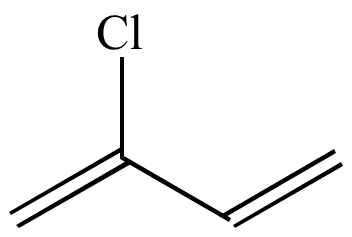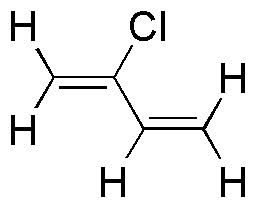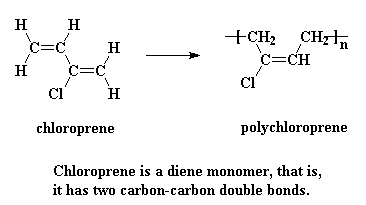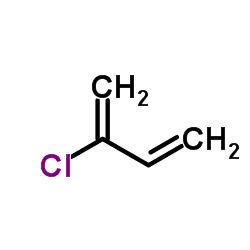Appearance Colorless liquid Formula C4H5Cl Molar mass 88.5365 g/mol | Related compounds Density 960 kg/m³ Boiling point 59.4 °C | |
 | ||
Chloroprene is the common name for the organic compound 2-chlorobuta-1,3-diene, which has the formula CH2=CCl−CH=CH2. This colorless liquid is the monomer for the production of the polymer polychloroprene, a type of synthetic rubber. Polychloroprene is better known to the public as Neoprene, the trade name given by [DuPont].
Contents

Production of chloroprene

Chloroprene is produced in three steps from 1,3-butadiene: (i) chlorination, (ii) isomerization of part of the product stream, and (iii) dehydrochlorination of 3,4-dichlorobut-1-ene.

Chlorine adds to 1,3-butadiene to afford a mixture of 3,4-dichlorobut-1-ene and 1,4-dichlorobut-2-ene. The 1,4-dichloro isomer is subsequently isomerized to 3,4 isomer, which in turn is treated with base to induce dehydrochlorination to 2-chlorobuta-1,3-diene. This dehydrohalogenation entails loss of a hydrogen atom in the 3 position and the chlorine atom in the 4 position thereby forming a double bond between carbons 3 and 4. In 1983, approximately 2,000,000 kg was produced in this manner. The chief impurity in chloroprene prepared in this way is 1-chlorobuta-1,3-diene, which is usually separated by distillation.
Acetylene process

Until the 1960s, chloroprene production was dominated by the "acetylene process," which was modeled after the original synthesis of vinylacetylene. In this process, acetylene is dimerized to give vinyl acetylene, which is then combined with hydrogen chloride to afford 4-chloro-1,2-butadiene (an allene derivative), which in the presence of copper(I) chloride, rearranges to the targeted 2-chlorobuta-1,3-diene:
HC≡C−CH=CH2 + HCl → H2C=C=CH−CH2ClH2C=C=CH−CH2Cl → H2C=CCl−CH=CH2This process is very energy-intensive and has high investment costs. Furthermore, the intermediate vinyl acetylene is unstable.

This "acetylene process" has been replaced by a process which adds Cl2 to one of the double bonds in 1,3-butadiene instead, and subsequent elimination produces HCl instead, as well as chloroprene.
Transportation regulations
Transportation of uninhibited chloroprene has been banned in the United States by the US Department of Transportation. Stabilized chloroprene is in hazard class 3 (flammable liquid). Its UN number is 1991 and is in packing group 1.
